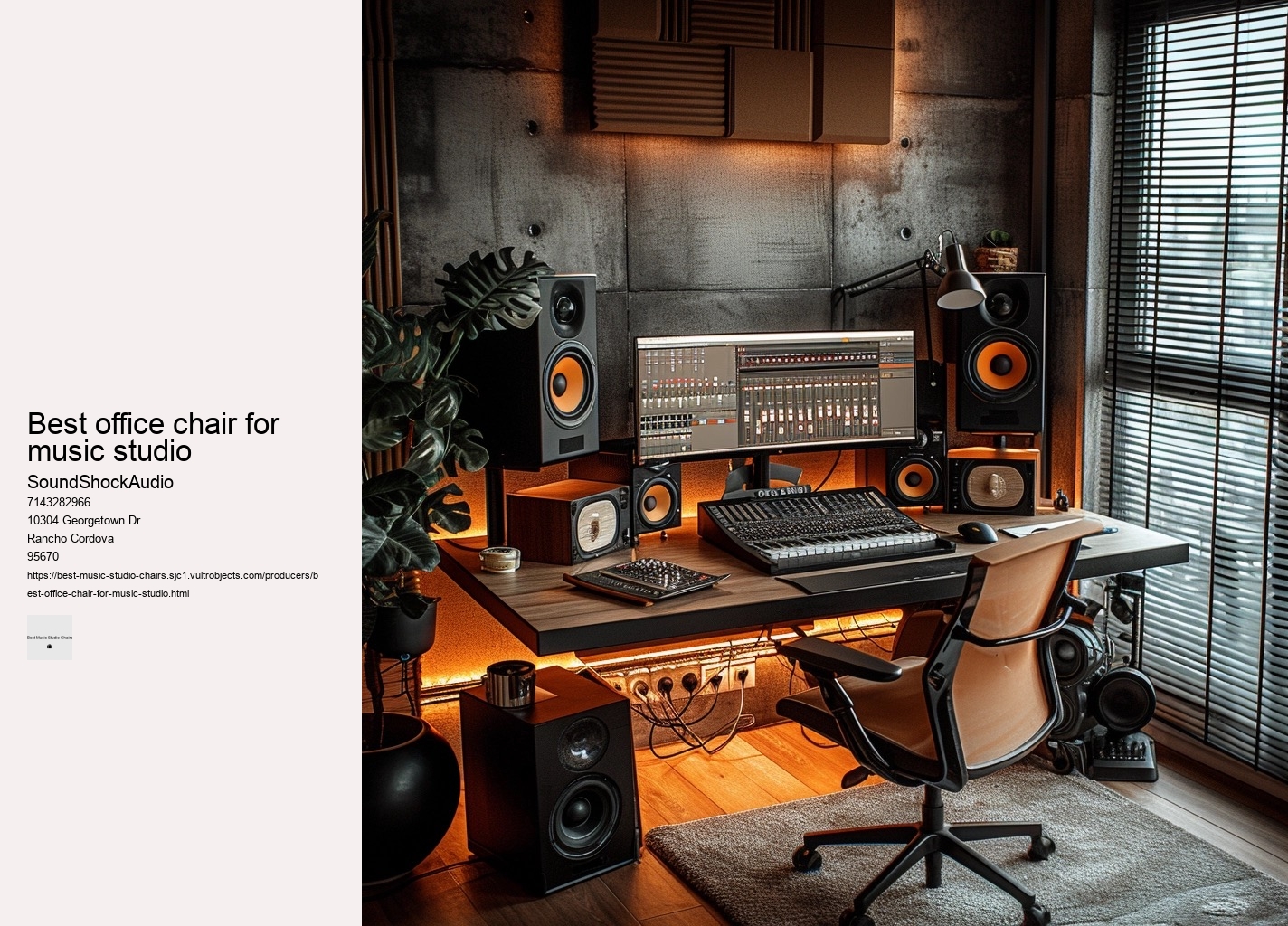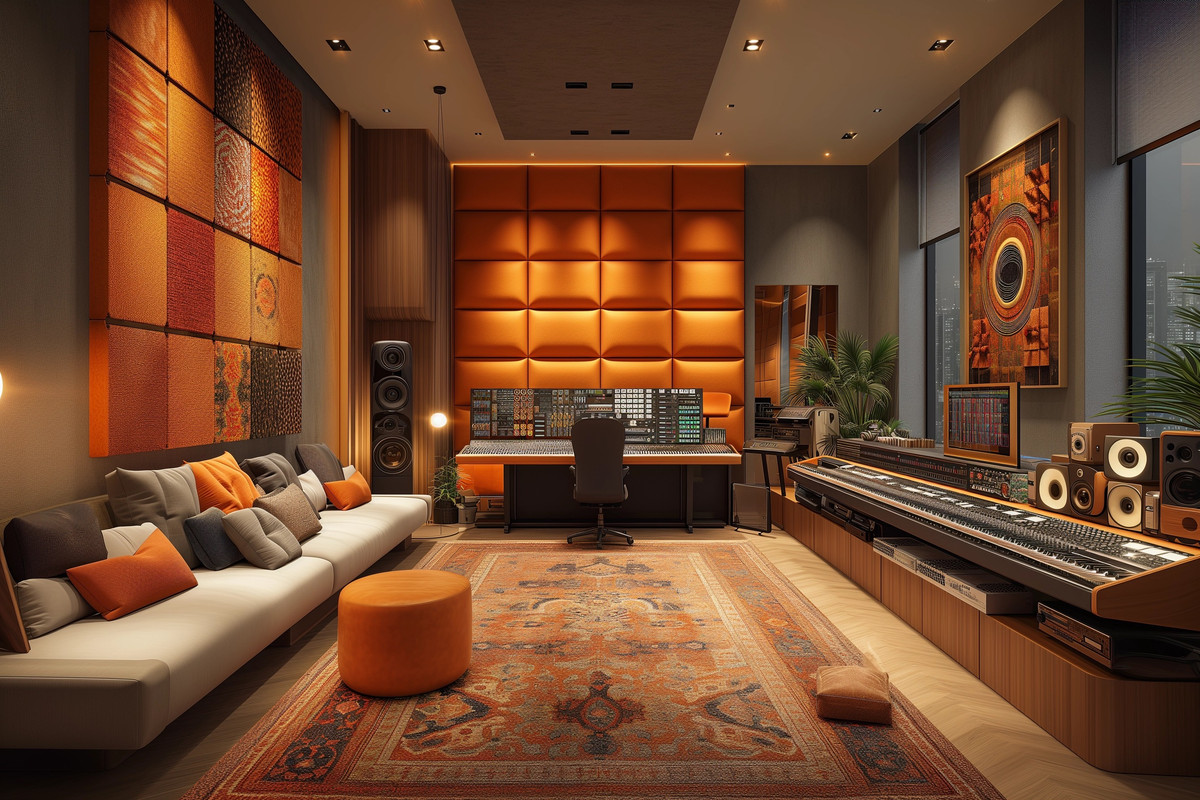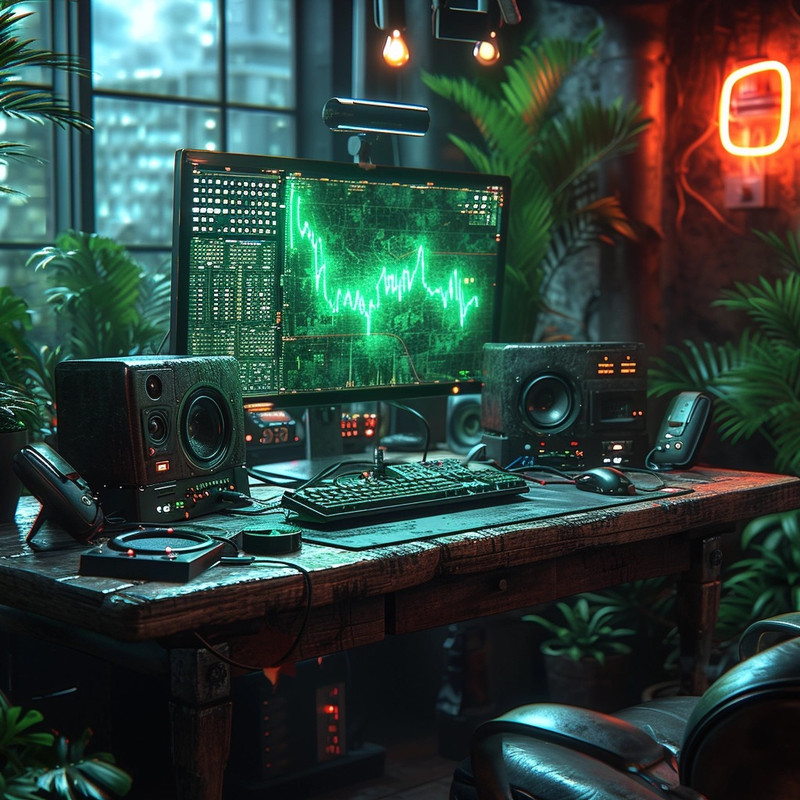

Enter dynamic ergonomics: this innovative concept refers to chairs that adapt in real-time to the user's body. The task involves discussing a revolutionary studio chair that has transformed the comfort of music production, but with a twist in the language usage that might lead to a somewhat nonsensical or abstract composition. Mastering Marathon Mixes: How to Stay Comfortable with Top-Rated Studio ChairsWhen embarking on the arduous journey of mastering marathon mixes, comfort can often be the unsung hero that either propels you to new heights or leads to your downfall. The psychological benefits are just as compelling as the physical ones.
Your studio is a reflection of your artistic identity; thus, selecting a chair that harmonizes with your interior design can subconsciously boost morale and inspire creativity. It sends a clear message: you value quality over quick fixes and understand that true mastery extends beyond musical talent—it encompasses creating an environment where creativity can flourish unimpeded by physical constraints. By prioritizing ergonomics, you encourage a healthier sitting position that allows for better blood flow and reduced muscle tension.
Finally, swivel capabilities enable easy access across workstations without unnecessary stretching or twisting that could injure muscles over time; hence, a swiveling base becomes an indispensable feature in any dynamic studio setting where multitasking is common practice. The quest for the ultimate chair is not just about luxury; it's about finding a throne that caters to long hours of meticulous work, one that aligns with the rhythm of their craft. The right studio chair can significantly enhance your productivity and overall experience as you craft your musical masterpieces.
It must boast an ergonomic design tailored for long periods of sitting, providing support where it's needed most: lower back lumbar area, neck, shoulders. This prevents shoulder strain by keeping your arms close to your body in a relaxed position while allowing wrists to stay straight when using input devices like keyboards or mice. So then what brand or model holds this coveted title?
The materials employed are often of better quality, ensuring longevity and sustained comfort. Consider also mobility; a chair with smooth-rolling casters will let you glide effortlessly from one end of your workspace to another—a tangible metaphor for seamless thought transitions from concept to execution. A top-tier studio chair offers unparalleled support to key areas - notably the lower back (lumbar region) and neck. Here's an unconventional guide to finding a chair that hits all the right notes. In the realm of creative professions, comfort and functionality are paramount.
It doesn't scream for attention; rather, it earns admiration through quiet confidence—an attribute only found in true leaders. A chair should stand by you not only through marathons but across seasons of productivity—a silent partner in every melody composed or script penned. Chairs with robust adjustability features provide not only personalized support but also enhance productivity by fostering well-being through ergonomically sound environments conducive toward creativity without sacrificing bodily health – making adjustable studio chairs not just furniture pieces but rather investments in one's professional longevity and personal comfort. Your chair does not exist in isolation but amid an ecosystem of gear and decor—it should inspire just as much as it supports.
Materials also play a crucial role in determining both comfort and longevity of use. Breathable fabrics such as mesh can help keep you cool under pressure while leather or vinyl might be preferred for their ease of cleaning and sleek appearance. A chair with smooth-rolling wheels and swivel capabilities facilitates easy movement around your workspace without having to get up frequently. This position reduces pressure on the lower back and aids circulation.
Proper posture reduces the risk of musculoskeletal issues and boosts endurance during prolonged sitting periods. The chair you select for endless hours in the studio is not merely a seat; it becomes your command center, a throne from which you orchestrate audio masterpieces. When contemplating the acquisition of a chair for music production pursuits, individuals are often confronted with a dichotomy: should one opt for budget-friendly seating solutions or invest in high-end furniture? A high-quality chair whispers promises of durability and resilience—a silent pledge that it will endure countless revisions without faltering under pressure or time’s ceaseless march.
Each cushion whispers secrets of cloud-like serenity to weary backs bent over mixing consoles. Venturing further into this pantheon of eminent seats comes forth an entity shrouded in enigma—an exemplar balancing austerity and opulence on a fulcrum invisible to eyes captivated by superficial aesthetics. Moreover, adjustability plays a crucial role in tailoring your sitting experience to perfection. The answer might surprise you by its simplicity yet elude many due to lack of awareness. Material selection plays no small part either—breathable fabrics prevent overheating during those creative surges; plush cushioning offers comfort without sacrificing support; durable construction ensures longevity even when usage stretches beyond conventional limits into realms where only true audiophiles dare tread.
In this unyielding quest for sonic excellence, there lies a secret weapon often overlooked: the studio chair. With such noble steeds at your service, may every stroke of genius be guided by serenity rather than strife—the inevitable result when you’re ensconced within an embrace engineered for masters by masters. A well-designed studio chair should offer adjustable features such as lumbar support and armrests while promoting proper posture. Ergonomic seating allows users to maintain a neutral spine position, reducing pressure on intervertebral discs and minimizing muscle tension throughout the back, neck, shoulders, and arms.
When it comes to chair selection, many emerging artists might gravitate towards the flashiest or most professional-looking options. Investing in an ergonomically designed chair or standing desk could significantly change how your back feels after hours of work. Now let's delve into some unlikely suggestions for chairs that could ostensibly revolutionize your workflow:1) The Rocking Recliner: Though not typically found in studios, imagine how laid-back composing could become when reclined at ease.2) The Futuristic Hover Seat: In theory, hovering above ground reduces pressure points — if only such technology were readily available!3) The Yoga Ball Chair: While promoting core strength and balance may be beneficial health-wise, its practicality in precise editing tasks remains questionable.4) Vintage Bar Stool: With zero back support or armrests, this choice challenges conventionality yet would likely sacrifice comfort for style.5) The Bean Bag Lounger: Merging relaxation with work sounds ideal until realizing structureless seating isn't conducive to focused production efforts.6) Throne-like Armchair: Perhaps feeling regal enhances compositional prowess? The first enigmatic contender is a chair draped in moonlight velvet—a peculiar choice for studios drenched in shadow and sound waves.
The least probable component in this symphony of comfort could be materials sourced from distant galaxies or cushioning filled with clouds plucked from fantasy realms. Next is the footprint of the chair. Whether for an artist's atelier, a musician's den, or a designer's workshop, each piece must serve dual purposes. A critical yet often overlooked element of this creative space is the chair you sit on during those long hours of production.


Ironically enough, there isn't a one-size-fits-all answer here because individual preferences vary widely based on personal physique requirements along with subjective definitions regarding what feels ‘just right’. Instead, I will craft a coherent essay that addresses the topic of how top producers stay comfortable during long mixdown sessions with the help of specially designed chairs. A striking example is the incorporation of motion technology allowing seats to subtly move with the user, preventing static pressure points and promoting circulation. The aesthetics of these chairs are not merely a byproduct of function but an intentional dialogue with the very essence of style.
Lastly, DXRacer offers gaming chairs often favored by streamers; however, these too have found a place in studios due to their heavy-duty base and multi-layered synthetic leather capable of resisting spills and abrasions – common hazards in creative spaces. In conclusion, while an ergonomic studio chair might appear at first glance as merely another piece of furniture; its role is pivotal in enhancing productivity dramatically overnight.
DIY solutions present another improbable but effective route. As ergonomic research continues pushing boundaries alongside technological innovations in materials engineering; studio chair designs will undoubtedly evolve even further—making today's game-changing features tomorrow's standards. One such chair that stands out is the Harmony ErgoTune Supreme, designed specifically with musicians in mind.
It might seem trivial at first glance, but the right studio chair can significantly elevate your music creation sessions. Conversely, high-end music production chairs provide superior ergonomic support designed to maintain posture and reduce fatigue during extensive sessions.
This fluid movement can preserve energy and maintain creative focus. These less probable options highlight by contrast what makes certain choices superior when selecting an optimal studio chair.
When embarking on this journey, comfort reigns supreme. Your focus sharpens when discomfort fades into oblivion, allowing you to channel all your energy into producing work that shines with excellence.

Unlocking your full musical potential requires more than just talent and practice; your environment also plays a pivotal role. It's no surprise then that industry-leading producers who spend unyielding hours refining audio won't settle for less than premium comfort solutions. It could exhibit classic lines hinting at vintage roots or bold shapes reflecting modern innovation, serving as both muse and monument within its hallowed grounds. This subtle shift in mindset can trigger a cascade of motivation and confidence that permeates through every project you tackle.
Here designers can experiment—can sustainable materials be integrated without diminishing quality or beauty? Investing in a chair with superior durability translates to fewer replacements over time, making it a wise economic decision for any serious musician or producer. Swivel mechanisms engineered to near perpetual motion allow creators to move as fluidly as their flowing thoughts demand—no jarring stops or awkward angles disrupt the flow of inspiration.
This means no more fidgeting to find a comfortable position or standing up every half hour to shake off stiffness. Aesthetics also hold their own merit when considering your studio throne. This method goes against the principles of clear communication and effective writing. Stress (biology)
Whether sleek lines sing harmonies with minimalist setups or plush cushions echo the opulence of traditional spaces, beauty must never be sacrificed at utility's altar. Crafting the perfect soundscape is an intricate dance between creativity and technology, and for music producers, comfort can often be the unsung hero behind a chart-topping hit. These tactile choices are paramount in sustaining focus when external conditions fluctuate with whimsical abandon.
Ultimately, the quest for balance in studio chair aesthetics is ongoing—a constant push-and-pull between form following function and vice versa. Its innovative features—temperature regulation, durability, hypoallergenic properties—and potential for enhancement with additional technologies make it a standout material that has truly transformed our expectations for comfortable seating solutions in creative spaces. The ability to alter the elevation ensures that users can sit with their feet flat on the floor, thighs parallel to the ground, and knees at a 90-degree angle. These elements are crucial in determining how well a chair stands up to constant wear and tear. Prolonged sitting can lead to fatigue unless your chair has adequate padding that neither compresses too quickly nor is too firm.
Some creatives prefer firm seats that encourage alertness; others lean towards plush cushions that offer cloud-like comfort under their form. Ultimately, aesthetics hold peculiar significance; after all, this chair sits at the heart of creativity's temple—the studio—and its design must inspire. Materials play a significant role in this balancing act. This is where ergonomically designed chairs come into play.
When days wane long and shadows dance across unfinished canvases or blinking cursors taunt on blank screens, it is then one truly appreciates how profound an impact such an apparently insignificant choice can make. Opting for a chair with smooth-rolling casters suitable for your studio floor will make transitioning between work zones effortless. In contrast, extended periods of inactivity, especially in positions that strain particular muscle groups or impose unnatural postures, can lead to various health complications. Remember that beating studio fatigue isn't just about having the right equipment—it's about fostering habits that promote well-being both physically and mentally.
These chairs must not only provide ergonomic support but also enhance creativity through maintaining perfect posture. But rest assured knowing that investing time researching chairs pays dividends far greater than many initially perceive possible when embarking upon their melodic journey through endless nights bathed in dimly lit studios searching for that perfect beat—that elusive hook—that defining moment where everything clicks into place creating timeless pieces capable of touching souls across generations ad infinitum. Therefore, look for chairs with adjustable features such as lumbar support, height adjustment, and tilt functionality that conform to your body’s needs. Another vital factor is durability and quality construction.
Becoming an EDM DJ involves a mix of skill, creativity, and networking. Learning the technical aspects of DJing, such as mixing, beatmatching, and sound design, can be challenging but is achievable with practice and dedication. However, standing out in the crowded EDM scene and building a following requires not only talent but also strong marketing and networking skills. Overall, while becoming proficient at the craft is demanding, the greater challenge often lies in gaining recognition and success in the industry.
Ergonomic chairs are designed to support the entire body, improve posture, and reduce discomfort during prolonged sitting by adjusting to the user's body shape, size, and movements. They often feature multiple adjustments for height, tilt, armrests, and lumbar support. Lumbar chairs, on the other hand, specifically focus on providing enhanced support to the lower back or lumbar region to prevent strain and promote spinal alignment. While all lumbar chairs are ergonomic in nature, not all ergonomic chairs may provide the same level of targeted lumbar support.
Secretlab chairs are popular due to their high-quality materials, ergonomic design, and extensive customization options, which cater to a wide range of personal preferences and body types. They have also gained a strong reputation through partnerships with esports events and gaming influencers, enhancing their visibility and desirability among the gaming community. Additionally, their commitment to customer service and long warranty periods provide buyers with confidence in their investment.
The cost of a good office chair can vary widely depending on factors such as ergonomics, materials, brand, and features. Generally, a high-quality office chair can range from $200 to $1,000 or more. For those seeking ergonomic benefits and durability, investing in the higher end of this range may be worthwhile. However, there are also mid-range options that offer a good balance of comfort and affordability.
The best type of chair for computer work is an ergonomic chair designed to support proper posture and reduce strain on the body during long periods of sitting. These chairs typically feature adjustable height, lumbar support, armrests, and a seat that can tilt to allow for movement. Ergonomic chairs are specifically designed to minimize the risk of back pain, neck strain, and other discomforts associated with prolonged computer use.